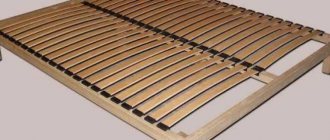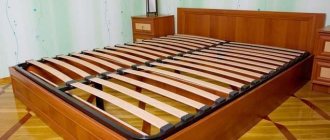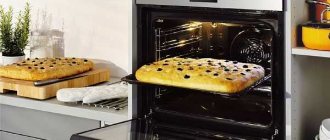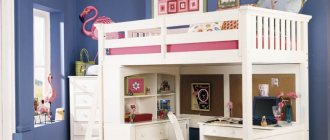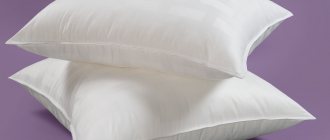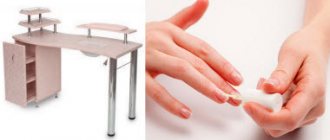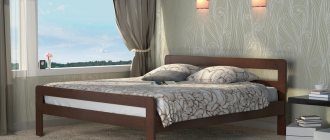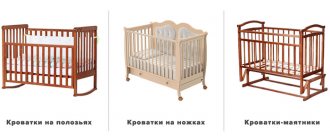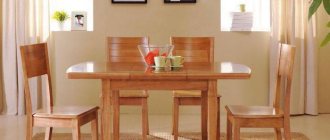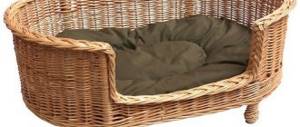Mattress size
It is important that the dimensions of the mattress (height, length and width) perfectly match the dimensions of the bed. If you are just about to purchase a bed, we recommend that you pay attention to the dimensions of the sleeping place (the inside of the bed) indicated in its description.
In this case, external dimensions do not matter. If you already have a bed, you need to measure its internal dimensions: width, length, height.
You will select a mattress based on these parameters.
p, blockquote 8,0,0,0,0 –>
After taking measurements, you will most likely get results that either correspond to standard mattress sizes or differ by a few centimeters.
p, blockquote 9,0,0,0,0 –>
Furniture and mattress manufacturers try to adhere to uniform standard sizes, so choosing the right size mattress does not cause problems. For an additional fee, which varies between 5-10%, we are ready to produce a mattress of non-standard sizes in increments of 5 cm according to your order.
Mattress length
The main rule when choosing a mattress is that the length should be 15 cm greater than your height.
p, blockquote 11,0,0,0,0 –>
Traditionally, the mattress has a length of 200 cm, which is a universal option for almost any height. If you are 175 cm tall, you will be quite comfortable on a mattress whose length is 190 cm. At the same time, there is an intermediate size of products - 195 cm.
Mattress width
It is customary to conventionally divide mattresses into single and double, focusing on width. Standard sizes of single mattresses: 80x190, 80x200, 90x190, 90x200. Standard sizes of one-and-a-half-size mattresses are 120x190, 120x200.
p, blockquote 13,0,0,0,0 –>
Double mattresses are products with a fairly large width from 140 to 200 cm (step - 20 cm).
p, blockquote 14,0,1,0,0 –>
The most popular standard mattress size for a double bed is 160x200 cm.
p, blockquote 15,0,0,0,0 –>
Expert opinion
Mikhailova Maria Vasilievna
Furniture store manager. Knows everything about comfort and interior design
Mattresses with a width of 180 and 200 cm are considered family mattresses. This is an option for families with small children. This mattress can accommodate dad, mom and baby.
p, blockquote 16,0,0,0,0 –>
Line of standard sizes of double mattresses: 140x190, 140x200, 160x190, 160x200, 180x190, 180x200, 200x200.
p, blockquote 17,0,0,0,0 –>
Mattress height
An orthopedic mattress should have a height (thickness) slightly greater than the internal height of the side of the bed. If the owner of the mattress weighs heavily, it is recommended to give preference to products with increased height.
p, blockquote 19,0,0,0,0 –>
Products with a small thickness of 2-10 cm are usually used as mattresses for sofas or mattress covers.
Standard sizes of single mattresses for adults
Let's consider the main dimensions of a single mattress such as length, width and height.
Width
If in Soviet times there were only two lines of mattresses in length and width - 80 or 90 cm by 1.9 or 2 m, now there are at least five varieties of bed width:
- Minimum width – 80 cm;
- Enlarged – 85 cm;
- Standard – 90 cm;
- Enlarged standard – 95 cm;
- Comfort – 1 m.
There may be other options, more non-standard, depending on the furniture. The usual width of a sleeping place is considered to be 80-99 cm, fluctuations up or down are designated as children's or one and a half.
Length
The length of mattresses (spring and springless mattresses, orthopedic) has also undergone changes towards expanding options:
- Standard – 1.9 m;
- Increased standard – 1.95 m;
- Station wagon – 2 m.
When choosing a sleeping place, you need to take into account that the comfortable minimum length for a person is his height plus 15 centimeters.
Height
The third value - height - depends on the filler and the fabric from which the mattress cover is made. Fillers include cotton wool, springs, springless coconut fiber, latex, etc. Manufacturers' height size standards are as follows:
- Futons and toppers – 2-10 cm;
- Standard – 11-19 cm;
- High – 20-40 cm.
Products taller than 40 centimeters are quite rare and are usually made to order. Mattresses with these sizes belong to the elite or premium class. Sometimes orthopedic mattresses that do not have a separate classification can be made with this height.
Mattress sizes for teenage beds
As noted above, children often sleep in their children's beds until adolescence, but if the child is growing quickly or you are updating the furniture by making a fresh renovation in his room, then it is important to pay attention to the teenager's growth. If he is tall and continues to grow quickly, then the length of the mattress can be 190, 195 or 200 cm if you choose standard sizes.
Width – from 80 to 120 cm, as for standard single or one-and-a-half beds.
p, blockquote 33,0,0,0,0 –>
When choosing a mattress for a child and not finding the right size in the catalog that fits a child’s bed, do not forget that you can always make an individual order. But the cost of a mattress made to individual sizes is usually slightly higher than a standard one.
p, blockquote 34,0,0,0,0 –>
Good luck with your choice and healthy sleep for your child!
p, blockquote 35,0,0,0,0 –>
Author of the article Natalya Galuzinskaya, especially for “DveMama.ru”
p, blockquote 36,0,0,0,0 –>
Sizes of beds, mattresses, bases
Bed sizes
Beds from the Toris factory have the following standard sizes: Standard bed length: 180 cm, 190 cm and 200 cm. Standard bed width for beds made of solid beech: - single: 90 cm - single: 120 cm - double: 140 cm, 160 cm, 180 cm, 200 cm. Standard bed width for solid pine beds: - single: 80 cm, 90 cm - single: 120 cm - double: 140 cm, 160 cm, 180 cm, 200 cm. Standard sizes for bunk beds: Bed width 80 cm, 90 cm. Bed length 160 cm, 180 cm, 190 cm, 200 cm. An option for small ones is also offered children with a sleeping place 70 x 160 cm. If necessary, you can order beds of non-standard length in increments of 5 cm from the standard. In practice, tall people ordered beds with a bed length of 220 cm, but if necessary, we are ready to calculate a bed with other sizes. It is also necessary to take into account the standard sizes of beds in terms of the height of the berth, the height of the structure itself and the back of the headboard. The standard height of a sleeping place varies in the range of 49 – 50 cm and is achieved by combining the height of the orthopedic base located in the bed and the height of the mattress. As a rule, the orthopedic base is located at a height of 27-29 cm. The overall dimensions of the beds depend on the type of side frames and, with a minimum width, have a plus of 8 cm to the size of the bed. The overall length also depends on the type of headboard backrest and at the minimum width with a straight backrest it is plus 8 cm to the berth.
Mattress sizes
Standard length of mattresses 180 cm, 190 cm, 195 cm, 200 cm. Standard width of mattresses: - single mattresses 80 cm, 90 cm - one-and-a-half mattresses 120 cm - double mattresses 140 cm, 160 cm, 180 cm ., 200 cm. You can also order mattresses of non-standard sizes in increments of 5 cm in length and width. Height of mattresses Spring mattresses usually have a height of 19 cm and, depending on the type of spring block and interlayer system, can reach 30-35 cm. The most common height of a spring orthopedic mattress is 19-21 cm. Springless mattresses range in height from 8 cm to 29 cm.
Dimensions of orthopedic bases
Standard sizes of orthopedic bases from the Toris factory - width: 70 cm, 80 cm, 90 cm, 120 cm, 140 cm, 160 cm, 200 cm - length: 180 cm, 190 cm, 200 cm. With a base width of 80 cm, it can be ordered with a length of 160 cm, and bases measuring 70 x 160 cm are also offered for children's beds. If necessary, you can order bases of non-standard width or length in increments of 5 cm. Separately, the bases can be equipped with two types of legs, a standard height of 23 cm, or legs of adjustable height in the range from 15 to 27 cm. Please note, the base is Prime 1 with a width of 120 cm. and wider are made double, bases Flex, Biflex, Prime 2, Prime 5, Prime 9 are made double in sizes 140 cm and wider.
If you need additional information or a cost estimate for a bed or mattress of a non-standard size, call 495-517-71-00 | 977-270-92-09 | 915-496-44-38
What sizes of mattresses are there?
If we talk about the width and length of the mattress, they are usually divided into:
- Single (width from 70 to 90 cm, length up to 200 cm and above);
- One-and-a-half (width from 110 cm, length up to 200 cm and above);
- Double (width from 140 cm, length up to 200 cm and above).
p, blockquote 38,0,0,0,0 –>
Knowing the exact size of your sleeping area (mattress or bed) will help you quickly and confidently choose a quality mattress that will definitely suit you. After all, if the mattress is smaller than the sleeping area of the bed, it will move and cause discomfort during rest.
Conversely, a larger mattress will bulge and negate all orthopedic properties.
p, blockquote 39,0,0,0,0 –>
Depending on the number of people sleeping, the size of the bedroom and other individual factors, the size of the bed and mattress is selected.
p, blockquote 40,0,0,0,0 –>
Also, you should pay attention to the height of the future sleeping place.
- The standard height for spring models is 5-17 cm.
p, blockquote 41,0,0,0,0 –>
The principle of choice is based on the fact that the mattress is higher than the side of the bed.
Double mattress sizes
One of the main characteristics of a mattress is its size. Two people need more space so that movements during sleep do not disturb the person sleeping next to them. Standard double models have widths of 140, 160, 180 and 200 cm, and lengths of 190, 195 and 200 cm. This size range is available from all manufacturers. Buying a standard mattress will not be difficult. There are also non-standard sizes that will be made to order for you with a small surcharge. To determine the exact size, you need to measure the sleeping area of the bed. In some cases, the height of the product also plays a role. So a very high mattress can completely cover the headboard, while a low one cannot fit under the headboard. Pay attention to these parameters; as a rule, bed manufacturers always indicate the recommended height.
Non-standard mattresses to order in St. Petersburg
We sew mattresses to order according to customer sizes in St. Petersburg.
- You indicate:
- mattress length
- mattress width
- mattress height
- Make an advance payment.
- We make a custom-made cotton wool mattress for you according to your dimensions within 7 days.
- We deliver your custom-made mattress to a pick-up point or to your home.
h3 10,0,0,0,0 –>
You can order a cotton mattress of absolutely any size!
We will be happy to make for you a custom-made children's mattress from cotton wool; we will make custom-made mattresses for a sofa, couch, ottoman or any other furniture, including a mattress for a crib.
p, blockquote 58,0,0,0,1 –>
We will make custom teak mattresses from cotton wool in non-standard sizes to suit every taste, for example, cotton wool mattresses 200x200, 180x200, 160x200, 140x200, 80x200, in general, sewing custom-made cotton mattresses of absolutely any size!
Where to buy a children's mattress of the right size?
Having studied the catalog of children's mattresses on the website, you will find everything you need for a comfortable sleep. In order to make the right choice, consult with the online store manager. Our specialists will provide you with all the necessary information and recommend the optimal size of a children's mattress for your child.
By contacting, you can not only buy standard children's mattresses with various fillings, but also use the service of manufacturing custom-sized products to order.
Standard sizes of children's mattresses - do they exist?
The choice of children's mattress size depends on age. We made a small “cheat sheet”:
| Age | Newborn | 1-3 years old | 3-7 years | 7-12 years | Teenager |
| Dimensions | 60Х120, 65Х125 | 70Х140, 80Х150 | 80Х160, 80Х170 | 90Х170, 90Х180 | 90Х190, 90Х200 |
It is worth noting that first a bed is purchased for the child’s age, and then a mattress is selected for this bed. If you already have a crib, focus primarily on the geometric parameters of the sleeping place in it.
It wouldn’t hurt to take a centimeter or tape measure and measure the exact length and width. This is necessary so that the mattress manufacturer can produce a perfectly suitable mattress for the crib.
Then it will neither stand on end nor dangle on the base. This is important especially for children, since their sleep is very sensitive, and any inconvenience can lead to constant awakenings.
Custom-made children's mattresses
As for those cases when standard mattress sizes are still not suitable for a child’s comfortable time on the bed, you can always correct the situation and make an individual order. Before doing this, you should measure the height and width of the child’s shoulders and outstretched arms to determine the optimal length and width values. The child’s opinion about how soft and comfortable it is to lie on such a mattress, whether the back gets tired quickly, whether the limbs become numb, etc. will help determine the height.
It is worth remembering that most children do not maintain the same constant body position while sleeping, constantly turning over - this relates to the issue of a balanced ratio of the length and width of the mattress.
Why can't I order a mattress without exact measurements?
Expert opinion
Mikhailova Maria Vasilievna
Furniture store manager. Knows everything about comfort and interior design
In our country, the very old GOST 19301.3-94 applies to the geometric parameters of beds. It does not correspond to modern life and defines only 2 children's sizes: 60X120 and 60X140.
Other meanings in the understanding of GOST are non-standard. Manufacturers of cribs made a decision: since GOST does not specify a sufficient set of geometric parameters anyway, it makes sense to produce those values that are technologically convenient for them.
Therefore, each bed manufacturer has different ones. For this reason, children's mattress factories produce any size to suit the client's crib - without additional payments or extended deadlines.
How to choose a mattress for a crib next?
After you have decided on the length and width of the sleeping place, you need to choose the composition of the mattress. We have prepared a simple table for you with factors that are worth paying attention to:
| Age | Newborn | 1-3 years old | 3-7 years | 7-12 years | Teenager |
| Rigidity | hard | hard | moderately hard, medium | moderately hard, medium | moderately soft, medium |
| Filling and thickness | coconut, strutto, holofiber 6-8cm | coconut, strutto, holofiber 6-8cm + latex (natural or artificial), 6-12cm | alternating layers of latex and coconut, 10-12cm | spring block, alternating layers of latex and coconut, 14-16cm | PPU or blocks of independent springs with latex and coconut fillers, from 16 cm high |
Sizes of children's mattresses for beds for children: table
Complete rest for a body tired during the day is possible only in the most relaxed position. Only a truly high-quality mattress can provide this level of comfort.
Long gone are the days of identical cotton mattresses with the obligatory strings. The range of modern textile industry successfully offers more and more new, fundamentally new models of orthopedic mattresses.
Such a sleeping surface will allow the body to completely relax, relieving the strain on each muscle. When choosing such a sleeping miracle, you need to follow simple rules, especially paying attention to the material used and the optimal size of the mattresses.
Sleeping place for an adult
An adult needs an orthopedic mattress with a thickness of at least 16 centimeters; most springless options are of this thickness. And spring products have a minimum height of 18 cm, the highest height reaches 40 centimeters.
But these are already elite models that have multi-layer padding and increased comfort. But the most common standard models that are in demand are 15-25 centimeters thick.
Selection by weight
It is necessary to take into account the weight of a person when choosing a mattress . People who are overweight need to sleep on higher models, this is the only way they can feel comfortable.
Types of fillers
When studying the issue of choosing a children's mattress for a crib, you need to pay more attention to the filling option of the product. Pediatric experts say that in the early stages of a baby's development, the skeletal framework is formed and strengthened.
To avoid problems in the future, you need to choose a really good mattress; it’s better to spend more than once than to regret it later.
It is recommended to select filler from materials such as:
- Coconut coir. This is a completely natural product that is obtained by processing coconut fiber. The filler is quite hard and is able to create the necessary conditions for the flow of air and moisture. Does not absorb unpleasant odors, does not absorb water well. If we talk about expensive stuffing, then natural impregnation is used for production. Cheap models may use substances that are unsafe for children.
- Latex. It is also a natural element obtained from the sap of the Hevea plant. In some situations it can cause an allergic reaction; it is quite elastic, but softer than coir. The best solution would be a product that combines coconut and latex.
- Polyurethane foam. This is a tougher version of foam rubber. It can last a very long time, is safe, and provides the necessary passage of air and moisture. It lights up poorly and is used in the manufacture of orthopedic models.
- Struttofiber. This element does not cause allergies; it is produced using the press of natural and synthetic components. Excellent for use in winter - retains heat very well.
On video: how to choose a children's mattress.
Children's coconut mattress
Today, opinions about the “naturalness” of coconut filling are divided: some consider coconut the best filling for children’s mattresses, others are categorically against it.
It is worth understanding the reason for such disagreements. A coconut mattress is made from coir - i.e. fibers of the woody vessels of the coconut palm nut, 15-30 cm long. But to bind these coconut fibers together, natural latex or synthetic substances are used. This is where expert opinions begin to differ on this issue.
In low-quality coconut-filled mattresses from unscrupulous manufacturers, artificial additives reach 60-70 percent of the total mass, therefore, there can be no talk of any natural material!
From popular and reputable manufacturers such as
- Ascona,
- TOGAS,
- Ortmatic
- DreamLine,
- MaterLux,
- Latos,
- Lisna
The certificates of conformity that are attached to each product must indicate the percentage of use of synthetic substances.
Advantages of coconut mattresses:
- Rigidity - coir is rigid enough for the baby’s skeleton to form correctly, to prevent scoliosis. At the same time, it is comfortable enough for a good rest;
- Moisture resistance and odor resistance - even if the baby pees repeatedly, there will not be a persistent odor of urine, as, for example, with quilted and foam rubber analogues. It will not rot;
- Hypoallergenic - natural coconut fibers and latex filler do not cause allergies;
- Bactericidal - no lice, bedbugs or ticks
- Permeability and thermal conductivity - the porous structure of coir provides good ventilation, the child’s skin does not sweat, he is comfortable.
How to choose: since a coconut mattress contains latex, you can also determine its artificiality by smell - if it smells like rubber, you have synthetics. You can also focus on price - the most inexpensive children's coconut mattress is from the DreamLine company, it consists of 3 slabs of coir and costs from 2,700 rubles.
Orthopedic mattresses for babies
Perhaps this is the best option for a newborn baby. The optimal choice would be a springless orthopedic model. Most quality products are equipped with one or more fillers. It happens that pressed horsehair is used as stuffing.
The manufacturing process uses a pattern of alternating soft and hard layers, which allows for better rigidity and elasticity of the sleeping bag. In infancy, such a mattress is placed on one side so that the child sleeps on the hard side. Then, when it grows, the product can be turned over to the soft side.
Main varieties
As already noted, it is not only compliance with the dimensions of the bed that determines the quality of the base for the bed. This product is available in several forms:
- orthopedic;
- spring;
- springless;
- hypoallergenic;
- with coconut filling.
When choosing between types of mattresses for children's beds, it is necessary to take into account both the age and characteristics of the child's body. In particular, for newborns it is recommended to purchase springless products with a hypoallergenic coating.
The quality of children's sleep depends on the characteristics of the bed base. In addition, these parameters influence the development of the child in the first years of life. Incorrectly selected bedding can lead to curvature of the spine, which in the future will require complex physiotherapeutic procedures.
Spring
Such models are also divided into several types. For children, it is recommended to buy mattresses with an interdependent spring block. You can check this nuance without removing the coating. To do this, press on one edge of the mattress. If the product is lifted from the second side, then each spring under the coating is connected to the others.
Buying such bedding is justified for teenagers. Despite the fact that spring models do not cause significant harm to the spine, it is not recommended to place these products in the beds of young children.
This recommendation is due to the fact that a child can move out of bed due to the fact that when pressure is applied, one edge of the mattress rises. There are also models that contain several springs, combined into separate blocks.
These products do not have the above disadvantage.
Springless
Springless models are divided into the following types:
- Latex. They are considered the best option for a children's bed. Latex models evenly redistribute the load on the spine, preventing sweating and the appearance of harmful organisms such as dust mites.
- Polyurethane foam. This synthetic material is based on natural ingredients. Polyurethane foam mattresses are characterized by good elasticity and ensure the correct position of the spine during sleep. Models of this type are hypoallergenic.
- Made from viscoelastic foam. Microporous material is able to “remember” the anatomical features of a person, thereby providing comfortable rest.
Some mattress models are equipped with additional layers made of different materials: biofoam (not recommended for children as it emits odors), flexfiber (able to retain its original shape) and spunbond. The latter is more often used in bedding with springs.
Orthopedic
Orthopedic mattresses are available with both springs and other fillers. In the latter case, additional layers are provided that redistribute the load along the entire length of the bed. Orthopedic mattresses are recommended for children of all ages. Such models are able to maintain the shape of the back during sleep without sagging over time.
Orthopedic mattresses are required for children who have been diagnosed with disorders in the development of the spine. Models without a spring block are considered optimal. This is explained by the fact that such products last up to 15 years.
Coconut
Coconut filler is breathable, does not collect dust or moisture, and does not cause an allergic reaction. The material is characterized by increased rigidity. Due to this, coconut filler is used in the manufacture of orthopedic mattresses.
Requirements for mattresses for children's beds
Modern medicine has already proven the fact that a child grows throughout childhood and needs quality rest every day.
When choosing a mattress for a child’s crib, it is important for parents to take into account a whole range of parameters that meet the principles of ergonomics, ease of use and affordable cost of the product:
Appropriate size. A mattress suitable in size for any crib will not disturb the child’s restful sleep, which is important for organizing normal rest at night for him and his parents.
Maximum security. The even and perfectly smooth surface of the product should not contain decorative or functional elements, such as zippers and fasteners, buttons and seams that can damage the skin.
Orthopedic properties. Such parameters ensure proper distribution of the load on the children’s spine and promote complete relaxation and rest of the muscle frame and connective tissues that are tense during the day.
Hardness level. The optimal rigidity of the finished product will allow the baby to sleep in the correct position, ensuring that the correct position of the spine is maintained and the pain in the child’s back is reduced.
Ecological materials. During the production and sewing of mattress covers, only natural and environmentally friendly materials that meet high standards of sanitation and hygiene must be used.
Focusing on individual parameters and their combination, adults will be able to choose the best option for decorating a children's bed. Good mattresses for newborns must fully satisfy all requirements and ensure healthy sleep for the baby, for active wakefulness and knowledge of the world around him.
Children's cabinet furniture: 110 photos, characteristics and best models from leading manufacturersA chair for a schoolchild - tips and recommendations for choosing orthopedic and regular chairs for children
- Choosing a crib: criteria, functionality, mattresses, types and features of placement (125 photos)
